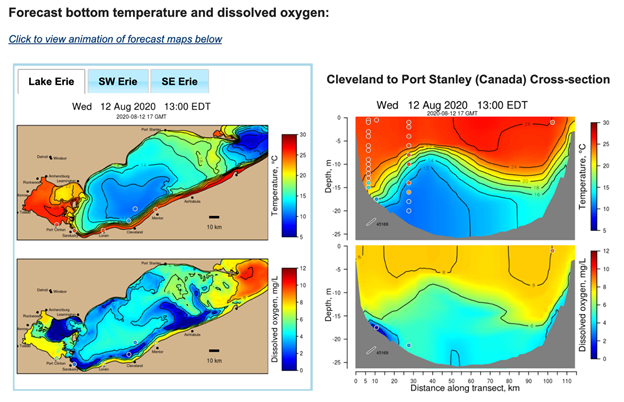Low dissolved oxygen (hypoxia) in a water body can certainly harm aquatic life, but it can also create problems for water treatment plant operators. Personnel have to respond quickly when low oxygen water reaches plant intake pipes to ensure continued delivery of clean, safe drinking water. However, not knowing when hypoxia can happen leaves them vulnerable.
To remedy this problem in Lake Erie, the NCCOS Coastal Hypoxia Research Program supports a collaborative project between the NOAA Great Lakes Environmental Research Laboratory, the Cooperative Institute for Great Lakes Research, and Cleveland Water to model when and where low oxygen can be expected to occur.
Hypoxic water is often associated with elevated manganese and low pH. Manganese can discolor treated water, and low pH may require adjustment to avoid corrosion of water distribution pipes, which can introduce lead and copper into the water. In the summer, biological activity in Lake Erie, fueled by high temperatures and nutrients from rivers and tributaries, goes into high gear. This activity, in turn, causes oxygen depletion in the depths of the lake’s central basin. Wind-driven water circulation can then move this deep water into shallow areas of the lake, where water treatment plant intake pipes continuously draw water for local residents.

Since 2017 the project has issued an experimental forecast that provides several days’ advance notice of when a hypoxic upwelling event will occur. Project scientists send public water systems, resource managers, and other researchers an email update with links to the experimental forecast website, the National Weather Service marine forecast, and real-time water oxygen measurements.
“This most recent forecast continues proving hypoxic events can be predicted, predictions are becoming more and more accurate, and these predictions are definitely useful. I see the prediction of this hypoxic event as continued justification for the usefulness of the hypoxia forecast model, and continue getting more and more comfortable with using this model as a routine tool to evaluate source water quality and treatment needs for our four water plants” said Scott Moegling, Water Quality Manager at Cleveland Water.
